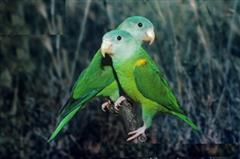Parakeet - Grey Cheeked
Grey Cheek Parakeet, Pocket Parrot, Orange Flanked Parakeet, Orange Winged Parakeet Scientific Name: Brotogeris pyrrhopterus
Wed, 8th January, 2025 - 6:30 am GMT
Sponsor Ads:

Alternative Name
Grey Cheek Parakeet, Pocket Parrot, Orange Flanked Parakeet, Orange Winged Parakeet Scientific Name: Brotogeris pyrrhopterusBasic Info
The Grey Cheek measures approximately 8 inches (20 centimeters) in length and weighs between 50 and 65 grams. Males and females cannot be distinguished by their appearance. If you want to know the sex of your Grey Cheek, it will need to be either DNA tested or surgically sexed. The Grey Cheek has a green plumage overall and of course has its Grey Cheeks, for which it was named. The green plumage on their under-parts has a more yellow tinge and is lighter than the plumage seen elsewhere. They have a bluish-green crown and grey foreheads. They have striking orange feathers on their axillaries, which may account for their other common name of Orange Wing Parrot. They have dark brown eyes and creamy orange colored beaks. Immature individuals have green crowns, and as they mature it will become more bluish in color.
Health
The Grey Cheeked Parakeet should receive a varied diet that can include pellets, a healthy seed mixture (with limited sun and safflower seeds, as these are fatty), millet, fruits, and greens and other vegetables. These birds also love banana and should be given banana regularly. Some hobbyists also report that they enjoy lorry nectar formulas as well. Vitamin C and mineral supplements are generally advised for this bird. Consult your vet about supplementation. The Grey Cheeked Parakeet is a very social bird and may be kept in groups. If they are to be kept singly, they will require a lot of attention. For a single bird a medium sized cage measuring approximately 18 inches wide should suffice. They should have plenty of toys, and also a bath, as these birds tend to love to bathe. Breeding In the 1980's thousands of these parrots were imported for the pet trade. Captive breeding programs since then have failed to produce a captive self-sustaining population. At this time most breeders are specialty breeders are using keeping all parrots within breeding programs. In the aviary, breeding season will usually begin in April. If they are allowed to breed in a communal aviary, females will often share a nest hole. The average clutch size is 4 to 6 eggs, with an incubation time of 23 days. Babies will fledge in 7 weeks. Since these are highly social birds it is not uncommon for multiple birds to share brooding duties.Habitat
Their habitat is within forests and arid scrublands.Behavior
The Grey Cheeked Parakeet is often described as a large bird in a small package, and once you get to know one, you will know why. The Grey Cheeked Parakeet is a gregarious bird with a fun loving personality. These small parrots are quite intelligent and are affectionate and outgoing. Like most parrots, it is recommended to get a hand fed individual. The Grey Cheek is reported to form strong attachments to its owners and is not shy about bestowing love and attention to those it bonds with. A well socialized Grey Cheek may often form bonds to multiple people, unlike some birds that will only bond with one person. Socialization is important. The Grey Cheek has been known to get protective and territorial over its owners. One owner called her Grey Cheek her "watch parrot". These are social birds, who like to be involved in whatever is going on at the moment. Like all parrots, these birds do require significant time and attention. This fact should be considered before bringing one into your home. While temperament and personality will vary between individuals, most Grey Cheeks are quite intelligent and fearless. Some Grey Cheeks have been trained to do tricks, and some have even been potty trained to only go on newspaper. This, however, may be limited to certain individuals and should not be expected. It should be noted that Grey Cheeks have been reported to become more aggressive during breeding season and when the reach sexual maturity. This is not uncommon for most parrot species. It is reported that parent raised Grey Cheeks may not have the sweet dispositions that the hand-fed Grey Cheeks are known for, though this will vary a lot between individuals. Even hand fed individuals may bite and they can have mood swings, like many other parrots. Some Grey Cheeks have been reported to talk, though they are not known to be great talkers like the African Grey. When compared to other parrots, such as Amazons and Macaws, the Grey Cheek is not a loud bird. Some may even do well in apartments, but they can be loud and may not be suited to all lifestyles for this reason. Like many parrots, they can, and often do scream if they do not feel they are getting the attention they deserve. The call of the Grey Cheek is reported to be a shrill metallic sound that is repeated quickly. They are typically classified as a medium-noisy parrot. The average Grey Cheeked Parakeet will live 15 years in captivity, though some have been known to live longer. At this time, due to difficulties with captive breeding, the Grey Cheek Parrot may be hard to find as a pet. Most breeders are choosing to keep their Grey Cheecks in breeding programs.Origin
South AmericaHistory
The Grey Cheeked Parakeet is native to South America and is seen in areas of Peru and Ecuador, where they live in large flocks. In tThey also seem to enjoy raids on banana plantations. Sadly, their populations are declining in the wild and they are now listed as "near threatened".Common Foods
he wild they feed on plant seeds, flowers, and fruit.Sponsor Ads:
"Never give in, never give in, never, never, never, never -- in nothing, great or small, large or petty -- never give in except to convictions of honor and good sense." -- Winston Spencer Churchill Address at Harrow School, October 29, 1941
Parakeet - Grey Cheeked
Coded by: BGID® | ALL RIGHTS RESERVED Copyright © 2000-2025
Disclaimer | Privacy | Report Errors / Contact | Credits








 President of the United States of America - Real Estate mogul, Pageant owner and now one of the most controversial men in political history.
President of the United States of America - Real Estate mogul, Pageant owner and now one of the most controversial men in political history.  Politician, US Vice President and President of the USA - Joseph Robinette Biden Jr.
Politician, US Vice President and President of the USA - Joseph Robinette Biden Jr.  versus
versus  Russia: 'The Evil Empire'? Are they all that bad or is it just the USA trying to portray Russia as bad because they are a world power with land bigger and a society very different from the USA ideal?
Russia: 'The Evil Empire'? Are they all that bad or is it just the USA trying to portray Russia as bad because they are a world power with land bigger and a society very different from the USA ideal?  Global warming has been in and out as the "latest" hot topic for many years. It is, according to modern scientists, the result of man-made industrial pollutants, clearing forested areas, agriculture, etc. But now they are thinking it started way before the Industrial Revolution...
Global warming has been in and out as the "latest" hot topic for many years. It is, according to modern scientists, the result of man-made industrial pollutants, clearing forested areas, agriculture, etc. But now they are thinking it started way before the Industrial Revolution... 
 Corona virus
Corona virus 
 Users with wide screen monitors can benefit from more content on every page.
Users with wide screen monitors can benefit from more content on every page.